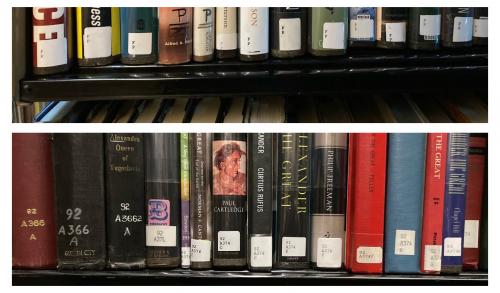Deciphering Call Numbers at the Society Library
You probably use call numbers regularly to find what you need at the Library, but have you ever wondered why they vary in format? Many people have experience with the Dewey Decimal Classification system, but we also use other formats for certain call numbers at the Society Library, such as fiction and biography.
Fiction is the simplest call number to decipher. We use an initial F to signify Fiction followed by the initial of the author’s last name. As an example, consider fiction by Jennifer Egan in F E as compared to fiction by Alex Marshall in F M. You’ll find fiction works by one author all together on the shelf. Due to the age of our collection, some older fiction books may only display the author’s last name initial on the spine of the book, but we can assume the F is present since fiction is the only group in the open stacks without a numerical class number.
The letter that stands for the author’s last initial is called a cutter (so named for Charles Ammi Cutter). A cutter can be used to represent the author, the title or the subject of the work. In most cases we use a cutter that is a single letter representing the author. However, in the case of biographies, we use an alphanumeric cutter comprised of a letter and a series of numbers further specifying the author or subject. How do you know the work has been classified as a biography? Our call numbers start with 92 if the work is a biography of a single subject. They start with 920 if the work is a collective biography or a collection of correspondence between people. Representing the subject’s name in the call number allows for works about the same biographical subject to sit next to each other on the shelf. To differentiate between biographies of the same individual, we use a second cutter to represent the main entry, which is usually the author or title of the work. As an example, consider a John Adams biography by Peter Shaw in 92 A214 S as compared to a John Adams biography by David McCullough in 92 A214 M.
While Stack 7 is exclusively biographies, biographical material can also be found elsewhere in the collection. Some biographical works are classed within the professional field of the individual, like the life and work of a painter among the art books or the professional life of a composer among the music books. Similarly, while Stack 5 and 6 are exclusively fiction, some fictional material can also be found elsewhere in the collection. Specifically, the literature stack contains critical editions or annotated editions that focus on the fictional work as the subject. These can be found in the 800s in Stack 9.
The Society Library has separated the individual biographies from the collective biographies (biographical material about more than one person). You’ll find those in the 920s in Stack 1 between the 919s and 921s and you’ll see that the format is similar to the singular biography class. The 920s have multiple biographical subjects, so the cutter usually represents the author or the title of the work. Be sure to check the catalog before heading to the shelf to search for biographical subjects.
The cutter system allows for easy browsing authors of fiction as well as biographical subjects, so there's no need to memorize our classification rules to find what you need. Don't be dismayed by the call numbers that look a little different from the typical decimal classification. Spend time in the fiction stacks (Stack 5 and 6) and biography stack (Stack 7) to get more familiar with the cutter system and more importantly to browse and discover the book you didn't know you were looking for.
Delve deeper into our call numbers and search our catalog by call number here: https://library.nysoclib.org/search/c


Disqus Comments